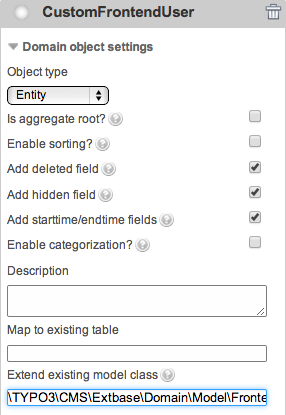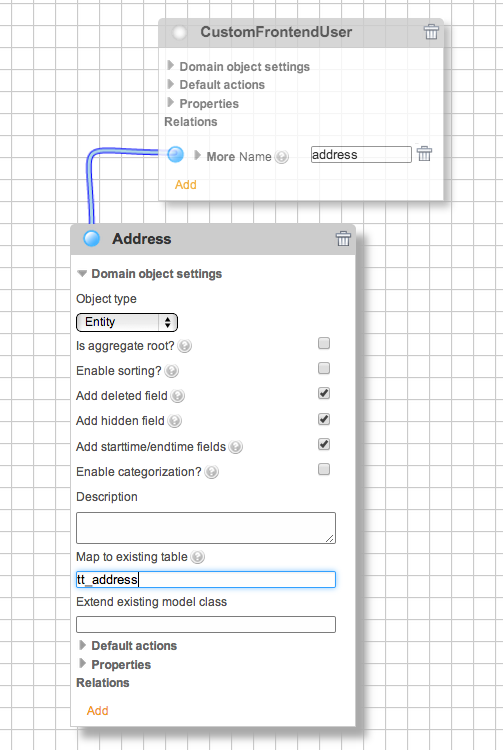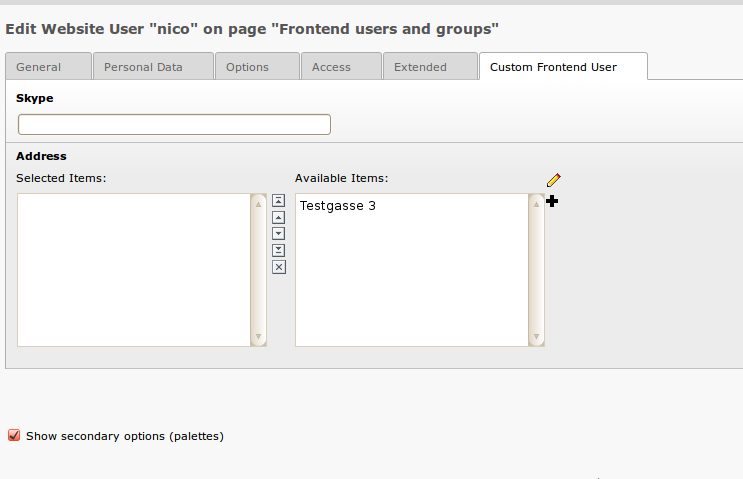Extending domain objects or map to existing tables¶
Since the TYPO3 Core already contains a number of database tables and domain object classes, it may prove useful to reuse or extend existing domain objects instead of creating new ones:
Extending domain objects¶
The Extension Builder supports single table inheritance.
This means you can extend domain object classes, either from your current
extension or from other extensions.
You must enter the fully qualified class name of the domain object you want to
extend in the Extend existing model class field in the domain object
settings form.
The class must be loadable, i.e. you can only extend classes of extensions that
are installed. After saving and updating the database (if necessary), you should
find a drop-down list Record Type and a new tab with the new properties in the
backend record form.
Note
Since single table inheritance depends on the $TCA[ctrl][type] field,
the Extension Builder tries to detect if a type field is already configured,
and if so, it adds your domain object class as new type.
Otherwise, the Extension Builder creates a new tx_extbase_type field
and configures it as a new type field.
This can lead to errors in certain cases. Especially if you don't see any
form at all when opening existing records in the backend, look at the type
field configuration and the existing values in the type field!
In this example, the frontend user domain object was extended:

Mapping to tables¶
If you want to store a domain object in an existing table, for example if there
is no domain object class for that table yet (like tt_address),
then you can enter the table name in the Map to existing table
field in the domain object settings form.
The Extension Builder will then add fields to this table for each property you
added to your domain object. If you name the properties according to the
existing field names, you can access the existing fields with the getters and
setters of your domain object class, and no new fields are created.
In this example the domain object is mapped to table tt_address:

and these are the resulting database updates:

and this is the backend form of the extended frontend user:

Note
Restrictions for single table inheritance
You should be aware that mapping to an existing table has some side effects:
Extbase stores the class name of the domain object instance in the table.
When it tries to restore the instance, for example when a parameter
tx_myext_myplugin[objectname]=23 is passed to a controller, it must
find the correct subclass.
This is implemented by a type field defined in $GLOBALS[TCA][<table>][ctrl][type].
But in many TYPO3 Core tables like pages or tt_content the type
field is used for other purposes, for example the type field of tt_content
contains the content type of the record and is used to find the correct
rendering definition for that record. Now when you map your domain object to
tt_content, a new type value is added that is not a rendering definition.
Another problem related to single table inheritance is that there is no real implementation in TYPO3 to avoid conflicts when multiple extensions extend the same domain object. If there are 3 extensions extending a news object, you always have to decide which domain object to use. You can't use the features of all subclasses in one domain object.
Caution
Do not use single table inheritance from external domain objects in extensions that you want to publish in TER and Packagist. Extension users have no control over how many other extensions try to extend the same object, which will lead to unexpected behavior!
Relations to domain objects of other extensions¶
If you want to add a relation to a domain object that is not part of your current extension, you must enter the fully qualified class name of that object in the relation settings form. The related class must be loadable, so you can only add domain objects from installed extensions.
Tip
Do not forget to enter the TYPO3 extension of the domain object your domain object inherits from in the Depends on field of the properties form. Only then the Package Manager will take care of the correct order when loading the extensions.
